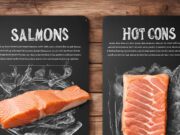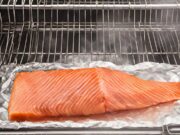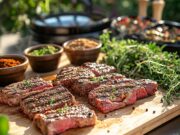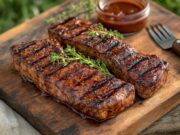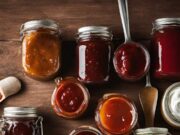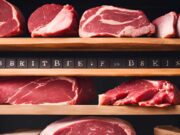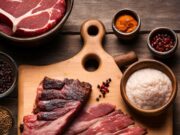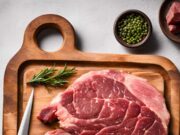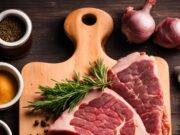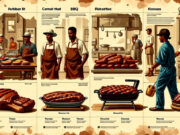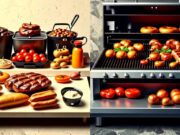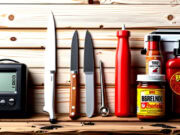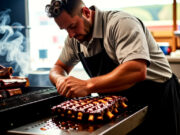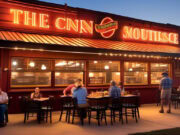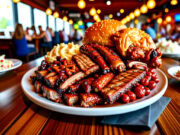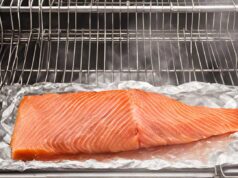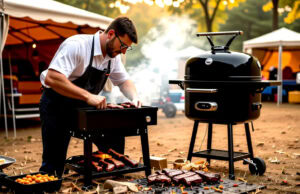Smoking food has been a revered technique for centuries, enhancing flavors and preserving ingredients.
This article examines the two primary methods of smoking: cold smoking and hot smoking. Each technique offers unique characteristics, processes, and applications within the culinary realm.
By understanding the differences between these methods, including their equipment, safety considerations, and flavor profiles, you will be equipped to make informed choices in your own kitchen.
Prepare to delve into the art of smoking.
Key Takeaways:
- Cold smoking and hot smoking are two different methods of food preparation and preservation, with distinct processes and outcomes.
- Hot smoking involves exposing food to heat and smoke, while cold smoking uses only smoke to flavor and preserve food.
- The choice between hot and cold smoking should be based on factors such as temperature, flavor preferences, and safety considerations.
Understanding Hot Smoking
Hot smoking is a cooking technique that involves both smoking and cooking simultaneously, enabling you to infuse rich flavors into meats like smoked brisket and smoked bacon while ensuring they are cooked to perfection.
The Hot Smoking Process
The hot smoking process involves utilizing a smoker box filled with wood chips to generate smoke at a specific temperature range. This technique allows the meat to absorb the smoky flavor while cooking thoroughly.
This method not only enhances flavor but also preserves the moisture within the meat, resulting in a succulent dish that is both aromatic and delicious.
To begin, it is essential to select the appropriate type of wood chips; fruit woods such as apple and cherry provide sweeter notes, while hickory and mesquite deliver a bolder taste.
Preparation techniques include seasoning the meat with rubs or marinades, which can further elevate the flavor profile. Maintaining an optimal temperature of around 225 to 250 degrees Fahrenheit is crucial for achieving a tender texture, and different meats require varying smoking times.
For instance, poultry may take 4-6 hours, while larger cuts like pork shoulders can require up to 12 hours, ensuring each bite is infused with deep, rich flavors.
What You Need to Hot Smoke at Home
To successfully hot smoke at home, you will need a reliable smoking device, such as a smoker generator or a traditional smoker box, along with quality wood chips to infuse your meats with exceptional flavor.
Plus these essential items, having a good digital thermometer is crucial for monitoring the internal temperature of your food, ensuring perfect results every time.
If you prefer a DIY approach, it is entirely feasible to create your own smoking setup using a simple grill and a smoke box made from aluminum foil or a steel container.
The type of wood you choose is vital for the flavor profile of your finished dish. For example, hickory imparts a strong, bold taste, while fruit woods like apple and cherry provide a milder, sweeter smoke, making them excellent complements for poultry.
Experimenting with various combinations can lead to uniquely delicious dishes that will satisfy any palate.
Understanding Cold Smoking
Cold smoking is a distinct smoking technique that enables the infusion of smoky flavors into foods such as smoked salmon and various types of fish, all while maintaining their delicate textures without subjecting them to cooking.
The Cold Smoking Process
The cold smoking process involves generating smoke at lower temperatures, typically below 90°F, which allows smoke particles to permeate the food without altering its texture, as is the case with smoked salmon.
To begin, you must prepare the food by thoroughly cleaning and, if necessary, curing it to enhance flavor and improve preservation. After preparation, you will need equipment such as a cold smoker or an offset smoker, as these setups allow smoke to circulate without adding heat to the food. A reliable thermometer is critical in this process; maintaining the proper temperature throughout the smoking period is paramount to avoid any safety concerns.
The ideal smoking duration varies depending on the type of food being smoked, generally spanning from several hours to a couple of days, which intensifies the taste while ensuring effective penetration of the smoke’s rich flavors.
What You Need to Cold Smoke at Home
To cold smoke at home, you will need specific equipment, such as a cold smoker or a DIY smoking device that enables proper airflow and smoke generation without cooking the food.
Plus the smoking apparatus, it is important to have tools like a thermometer to monitor temperatures, trays for placing food, and a water pan to maintain humidity levels.
When considering ingredients, using quality wood chips or pellets is essential for achieving the desired smoky flavor. Hardwoods such as hickory, applewood, and alder are particularly favored for smoking fish and meats.
For those just starting out, creating a DIY cold smoking setup can be straightforward. You can use a cardboard box or modify an old grill for cold smoking, allowing you to experiment with different flavors without a significant investment.
Comparing Cold Smoking and Hot Smoking
When you compare cold smoking and hot smoking, it becomes clear that the primary differences reside in the temperature range, the resulting smoke flavor, and the implications for food safety. Each technique has its own suitability for various culinary applications.
Key Differences: Temperature, Flavor, and Safety
The key differences in temperature, flavor, and food safety between cold smoking and hot smoking are crucial in determining the most suitable technique for various culinary applications.
Understanding how temperature influences the smoking process is essential for both chefs and home cooks. Cold smoking typically occurs at temperatures below 90°F, allowing the smoke flavor to infuse foods gradually, which is particularly beneficial for delicate ingredients such as fish and cheeses. On the other hand, hot smoking involves higher temperatures, generally ranging from 165°F to 250°F, which cooks the food while imparting robust, smoky flavors—making it ideal for meats and poultry.
Temperature also plays a vital role in food safety; maintaining proper heat levels is essential to prevent bacterial growth and ensure that food is safe to consume. Therefore, employing the appropriate smoking technique not only enhances flavor profiles but also prioritizes health and safety in food preparation.
Choosing the Right Smoking Method
Choosing the right smoking method, whether hot smoking or cold smoking, depends on your desired culinary experience, the type of food you are preparing, and the specific flavors you wish to achieve.
Beyond the initial choice between hot and cold smoking, there are several other critical factors to consider. Your flavor preferences play a significant role; if you enjoy a robust, hearty profile, you might lean towards wood types like hickory or mesquite, while fruit trees like apple and cherry can provide a sweeter, milder touch.
The type of meat or vegetables is equally important, as certain techniques work better with specific ingredients. For example, poultry often performs best with hotter methods, whereas larger cuts like brisket benefit from the low-and-slow approach of cold smoking.
Additionally, the smoking equipment available to you—ranging from traditional offset smokers to modern electric options—can further influence your smoking experience, guiding your selection toward techniques that yield the best results.
Frequently Asked Questions
What is the difference between cold smoking and hot smoking?
Cold smoking is a smoking process where the food is exposed to smoke at a temperature between 68°F and 86°F, while hot smoking is done at a temperature between 126°F and 176°F.
What types of food are commonly cold smoked?
Commonly cold smoked foods include fish, cheese, and vegetables. These foods are not cooked during the smoking process and are intended to be consumed raw or lightly cooked.
Which foods are typically hot smoked?
Hot smoking is commonly used for meats such as chicken, pork, and beef, as well as vegetables like corn and potatoes. These foods are fully cooked during the smoking process and are safe to eat without further cooking.
What are the main differences in flavor between cold smoking and hot smoking?
Cold smoking produces a milder, smokier flavor while hot smoking creates a stronger, more intense smoky flavor. The temperature and duration of smoking greatly affects the flavor of the final product.
Is one smoking method healthier than the other?
Both cold smoking and hot smoking can be done in a healthy manner, but it ultimately depends on the type of food being smoked and the ingredients used in the smoking process. Choosing high-quality, natural ingredients and controlling the smoking temperature and duration can make either method a healthy option.
Can cold smoking and hot smoking be combined?
Yes, some foods can be both cold and hot smoked to achieve a desired flavor and texture. For example, cheese can be cold smoked first for flavor and then hot smoked to melt and enhance the smoky flavor. Experimenting with different combinations can lead to unique and delicious results.




